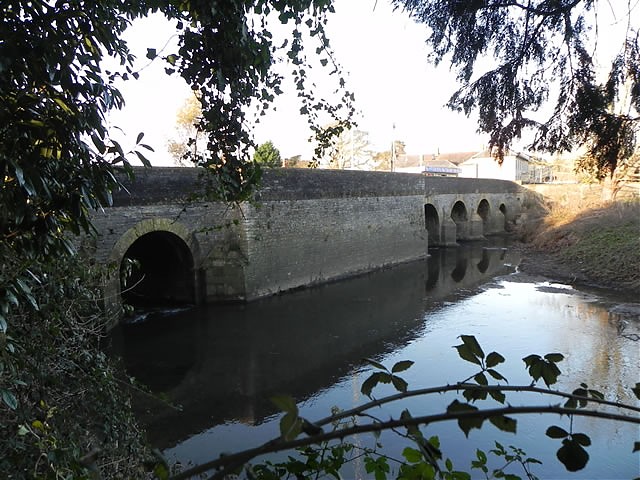Ilchester Bridge
 |
||||
| Bridge Name: | Ilchester Bridge | |||
| No.: | 18 | |||
| Location: | Ilchester Town | |||
| Build Date: | 1797 – Widened 1932 | |||
| Engineer: | ||||
|
© Copyright somersetrivers.org |
||||
| Description: | ||||
| The bridge was orginally late Cl2 or early Cl3 but was replaced between 1791-97. It had 7 arches with the central one on the island in the middle of the river. The 3 arches to the S of the island were on a different alignment to those on the N. A chapel and prison were situated on the sides.1
Road bridge over River Yeo (Ivel). Late C12\early C13, remodelled 1797. Local lias stone with Ham stone dressings. Seven arches in all, the most northerly being for the mill stream: in centre long passing bays each side (although bridge has been widened in C19 and C20): semi- circular arches with keystones, band course at road level, plain chamfered top stones, no coping as such; angled cutwaters to both sides the balustrading has concave curves at each end of passing bays, and right-angle returns at end, the north west return being extended. Scheduled Ancient Monument (Somerset County No 236). (VCH, Vol III, 1974).2 Uppon complaint made unto this Court by one Joshua Godfrey of Montague freemason that there is muche money due to him for worke about fower Bridges of this County in the westerne division viz. Ivelchester Bridge, Mudford Bridge, Petherton Bridge, and Load Bridge ; And for that Mr. Smith Treasurer of the Bridges in the said westerne division is att present unfurnished with money to pay and dischardge the same ; It is therefore ordered that Mr. Tucker of Shepton Treasurer of the Bridges within the easterne division of this County doe forthwith pay unto the said Mr. Smith Treasurer for the westerne Division as aforesaid the some of fortie pounds which the said Mr. Smith is to yssue out to the said Godfrey towards his satisfaction for the said moneyes due to him.3 Below Mudford the river runs a very tortuous course to Ilchester, where it is again crossed by a causeway which carries the famous Roman road, the Fosse Way. The present structure, built about the year 1825,has seven small arches each with a projecting keystone. The existing bridge displaces the great stone bridge of seven arches, which crossed the river in the 16th century. Leland entered the town from the south west, and recorded that ” there were in the middle of the bridge two little houses of stone, one on the right hond, wher the Commune Gaiol is for prisoners yn Somersetshir” “The other house on the lift hond the lesser of both semid to me to have bene a Chapelle”, Leland also mentioned ” a fre Chappelle in the Towne, the bakeside whereof cummith to the river side even hard bynethe the Bridge”. Stukeley, early in the 18th century, also recorded the existence of the two chapels. He stated that the one on the bridge was dedicated to Little St.Mary, and that the second chapel was called the white chapel. Both he added were converted into dwellings. 4 Width doubled 19325 |
||||
| References: | 1. Somerset HER Ref:53019 2. Somerset HER Ref:52544 3. Quarter Session Records Held at Wells 8th, 9th, 10th, 11th January 1649 4. The Ancient Bridges of the South of England by E.Jervoise published in 1930 5. Somerset Roads the Legacy of the Turnpikes – Western Somerset by J B Bentley & B J Murless |
|||
